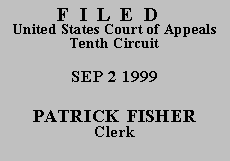

| UNITED STATES OF AMERICA, | No. 99-8007
(D.C. No. 98-CR-101) |
§ 2K2.1(b)(5) for possession of a firearm in connection with another felony offense, and that the district court used an incorrect legal standard in applying the enhancement to his offense level. Exercising jurisdiction pursuant to 28 U.S.C.
§ 1291, we affirm.
I
We review the district court's factual findings in support of a sentencing enhancement for clear error. See United States v. Valdez-Arieta, 127 F.3d 1267, 1270 (10th Cir. 1997). We review the district court's legal interpretation of the Sentencing Guidelines de novo. See United States v. Hargus, 128 F.3d 1358, 1364 (10th Cir. 1997), cert. denied, 118 S.Ct. 1526 (1998).
Section 2K2.1(b)(5) provides that "[i]f the defendant . . . possessed any firearm or ammunition in connection with another felony offense . . . increase [the offense level] by 4 levels." U.S.S.G. § 2K2.1(b)(5) (emphasis in original). In United States v. Bunner, 134 F.3d 1000, 1006 (10th Cir.), cert. denied, 119 S.Ct. 81 (1998), we held that if a "weapon facilitated or had the potential to facilitate the underlying felony, then enhancement under 2K2.1(b)(5) is appropriate." We further noted that "a weapon's proximity to narcotics may be sufficient to provide the nexus necessary to enhance a defendant's sentence under
§ 2K2.1(b)(5)." Id. (citing United States v. Gomez-Arrellano, 5 F.3d 464, 467 (10th Cir. 1993)).
The evidence in the record adequately supports the district court's determination that appellant possessed firearms in connection with the distribution of methamphetamine and marijuana. Numerous firearms were discovered in appellant's twelve foot by twenty-five foot, one-room residence. So were fifty-eight packets of methamphetamine, packages of marijuana, paraphernalia associated with the packaging and distribution of these drugs, and over $2,000 in cash. The record also indicates an informant stated that appellant sometimes used a gun in his drug transactions. Finally, in light of conflicting evidence regarding the number of loaded guns that appellant's father placed in appellant's residence and the number of loaded guns discovered there, the district court reasonably concluded that appellant himself loaded at least one of the guns. Based on this evidence, the district court reasonably concluded that appellant possessed at least two guns in connection with his offense of possession with intent to distribute methamphetamine, cocaine, and marijuana, thereby justifying application of the sentence enhancement under U.S.S.G. § 2K2.1(b)(5).
We are unpersuaded that the district court's failure to use the language "in connection with" in its findings regarding the applicability of this enhancement constitutes grounds for reversal. Evidence in the record amply supports the conclusion that appellant used firearms in connection with this drug offense. Moreover, based on the district court's fact finding, it is clear that the district court applied the correct test in conducting its analysis.
We reject appellant's assertion that the court's decision in Gomez-Arrellano, 5 F.3d at 466-67, renders erroneous the district court's imposition of a sentence enhancement. In Gomez-Arrellano, we concluded that an insufficient nexus existed to support an enhancement under § 2K2.1(b)(5). See id. at 467. The facts of that case, however, are clearly distinguishable from those of the current action. As the Gomez-Arrellano court noted, there was no evidence in that case concerning either the proximity of the weapons to the drugs or the size of the residence containing both weapons and drugs. Id. at 467. Here, evidence in the record demonstrates that drugs and weapons were all discovered within appellant's small, one-room residence, and that appellant sometimes used a weapon in his drug transactions.
Based on our review of the record, we conclude that this was sufficient evidence to support the district court's imposition of a four-level enhancement under § 2K2.1(b)(5).
AFFIRMED. The mandate shall issue forthwith.
ENTERED FOR THE COURT
Carlos F. Lucero
Circuit Judge
*.The case is unanimously ordered submitted without oral argument pursuant to Fed. R. App. P. 34(a)(2) and 10th Cir. R. 34.1(G). This order and judgment is not binding precedent, except under the doctrines of law of the case, res judicata, and collateral estoppel. The court generally disfavors the citation of orders and judgments; nevertheless, an order and judgment may be cited under the terms and conditions of 10th Cir. R. 36.3.